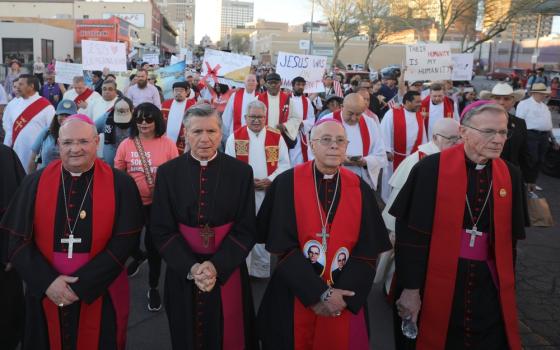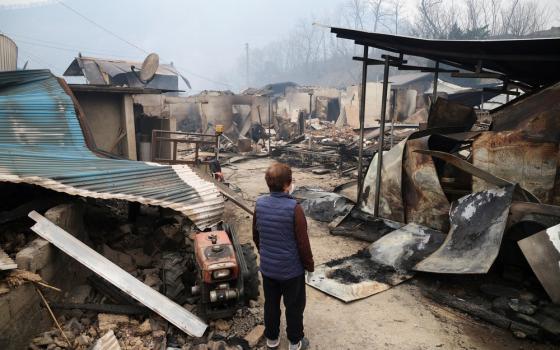The news that, including retired prelates, Chicago is now home to more bishops than monsignors means that the tipping point has been reached for clerical culture. Imagine the hierarchical church as a crumbling amusement park on whose lonely and littered midway one battered attraction survives -- a huge teeter-totter, one end dug into the ground like a dagger under the weight of its once easy rider bishops while the other sways like a construction crane clutching a cargo of lighter-than-air monsignors.
The bishops who once gazed down on the once respectful crowds now look up longingly at their once privileged space in the heavens; the monsignors who got neck spasms from looking anxiously upward for most of their careers are now stranded in mid-air with no place to go.
Chicago was once the imperial seal embossed on America's clerical culture. That's when Cardinal Mundelein rode to his brick replica of Mount Vernon on the seminary grounds in a limousine with crimson strutted wheels and would ask absently, on his way to a priest's funeral, "What was Father's name again?" Chicago still has a cardinal archbishop named Francis George who is also president of the U.S. Conference of Catholic Bishops. He is pleasant the way the man who sells you a suit is and just as hard to recall afterward. His phantom-like presence, except when he gets irritated with gays who want to receive the Eucharist together, is a symptom of the withering away of the clerical culture.
Clerical Culture, once the greatest show on earth, has not posted its closing notices but, like the three ring circus it so closely resembled in its days of glory, it has seen its tattered wonders outstripped by those of modernity, and the people are neither enticed by its barkers nor willing to believe in its clever illusions anymore. Its dissolution is a sign, starker than a symbol cut into a wheat field, of the collapse of the hierarchical pre-Vatican II establishment that so many righteous clerics are struggling to restore.
Ordinary Catholics love their church and their faith but long ago left the midway of the clerical culture circus. Yes, yes, they nod in recognition but what do we do now? The first thing, perhaps, is to stop debating with those out in the clerical cemetery trying to dig up the corpse of its culture. They are just digging the grave a little deeper. Watch the mournful scene and grasp the meaning of Jesus' injunction to let the dead bury the dead.
Save your energy and do not expect the institution or its leaders to become transparent in their practices or more forthcoming in their dialogue. They cannot be argued into responses that are unnatural for them. The transparency gene, like evidence of criticizing celibacy or being in favor of ordaining women, would have made them ineligible for positions of power in the French cuffed clerical Alamo they will defend to the last man.
Resist the strong temptation to develop "house churches" in which the Eucharist may be celebrated free of the present discouraging entanglements. Third parties don't work in politics and these third party endeavors, noble as they may be in intention and execution, sever a connection to the greater church as a people and encourage incurable clerics to think that they own the church that belongs to you.
Concentrate together on remaining loyal to the sacramental church and to pensioning off the declining soft-bitten clerics who want to turn it into an ecclesiastical spa. Perhaps the best formula yet devised for that is the Voice of the Faithful's simple mantra to support good priests and to change the church.
There are countless good priests who need support to carry on their own efforts to be true to the vision and documents of Vatican II. They include, for example, Msgr. Michael Ryan of Seattle who has been leading an heroic battle to reject the restoration of rococo liturgical texts, or Fr. John Heagle, often dispossessed in his wonderful mission of preaching and giving comfort to struggling Christians. Stand up for Fr. Richard McBrien, who has had more arrows shot at him than St. Sebastian for nothing more than writing a column that every week is a teaching vehicle for orthodox theology. There are thousands of priests -- along with dedicated religious men and women such as Sr. Joan Chittister and James Carroll -- who need our support in what often seems their thankless battle to maintain a healthy church.
Indeed, as the tipping point for clerical culture passes, the best way to resolve the still unhealed wound of the sex abuse crisis is less through putting bishops on trial than in ignoring them and putting all our energy into the great renewal of Catholicism that was begun by Pope John XXIII in convening Vatican Council II. Anything that brings healing to the abused is good but the bad seeds of its origin and the bad faith of those who work against its ultimate resolution will only be eliminated by a church out of the shadow of the broken down seesaw of clerical culture and flooded with the sun of wholeness, wholesomeness and holiness.
[Eugene Cullen Kennedy is emeritus professor of psychology at Loyola University, Chicago.]
Editor's Note: We can send you an e-mail alert every time Kennedy's column, Bulletins from the Human Side," is posted to NCRonline.org. Go to this page and follow directions: E-mail alert sign-up. If you already receive e-mail alerts from us, click on the "update my profile" button to add Kennedy to your list.




